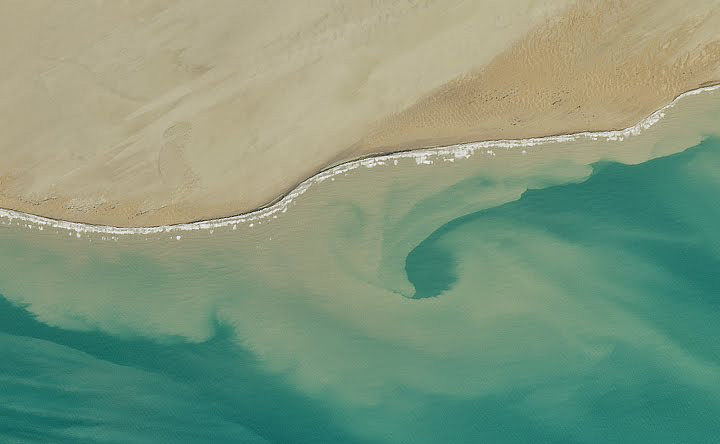
Every month on Earth Matters, we offer a puzzling satellite image. The July 2017 puzzler is above. Your challenge is to use the comments section to tell us what we are looking at, when the image was acquired, and why the scene is interesting.
How to answer. Your answer can be a few words or several paragraphs. (Try to keep it shorter than 200 words). You might simply tell us what part of the world an image shows. Or you can dig deeper and explain what satellite and instrument produced the image, what spectral bands were used to create it, or what is compelling about some obscure speck in the far corner of an image. If you think something is interesting or noteworthy, tell us about it.
The prize. We can’t offer prize money or a trip to Mars, but we can promise you credit and glory. Well, maybe just credit. Roughly one week after a puzzler image appears on this blog, we will post an annotated and captioned version as our Image of the Day. After we post the answer, we will acknowledge the person who was first to correctly ID the image at the bottom of this blog post. We may also recognize certain readers who offer the most interesting tidbits of information about the geological, meteorological, or human processes that have played a role in molding the landscape. Please include your preferred name or alias with your comment. If you work for or attend an institution that you want us to recognize, please mention that as well.
Recent winners. If you’ve won the puzzler in the last few months or work in geospatial imaging, please sit on your hands for at least a day to give others a chance to play.
Releasing Comments. Savvy readers have solved some of our puzzlers after only a few minutes or hours. To give more people a chance to play, we may wait between 24-48 hours before posting the answers we receive in the comment thread.
Good luck!
Answer: The image above shows the Makran Coast in Pakistan on May 25, 2017, when it was observed by the Operational Land Imager (OLI) on the Landsat 8 satellite. To the left of the image, the sediment-rich Hingol River feeds into the Arabian Sea. As its tan color indicates, the river frequently carries large amounts of sand and other debris. This is particularly true after a rare rain. Congratulations to Obaid-ur-rehman and j.roloff for their winning answers. Read more about the image in our July 29, 2017, Image of the Day.




Shelly Island? The island that formed rapidly off of Cape Hatteras.
Playa Teresitas in Tenerife – yellow sand hauled from Sahara and artificial barrier built to prevent sea from stealing the sand
A WINDSWEPT BEACH,MARKED BY BREAKING WAVES, SW WIND TRANSPORTS WHITE NEW SAND NE FROM BEACH,,OLDER SANDS REDDISH, OXYDISE,LONGSHORE CURRENT DRIFTS TOWARD EAST. SWIRL CAUSED BY RIP CURRENT TOWARDS OCEAN
Coastal sediment transport at play. The image captures the movement of sand in the water and also by wind on the beach. The big plume in the water is a rip-current flowing out to sea.
It looks like it could be a coastal desert, along Baja California, Namibia, Morocco or Australia.
It possibly has a high tidal range to explain the stretch of moisture running up on the right side of the beach.
Bear Lake, Idaho and Utah, USA
Suspended sediment load with revolving ocean current. Though Satellite image is presenting it in artisitic way but it is of great environmental concern for marine life. overloading of sediments may cause hypoxia (oxygen deficient condition) which in result may affect marine life. nature and composition of marine life will be changed with damaging habitat for certain species.
Coastal sandy berm ( bar) moved by Coastal processes created by wave refraction. The shape of nearshore corps seems to be associated to a mixture of grained-fine sediment both from ( river plume) and marine deposit ( bioclastic, quartz, etc). The corner shape crescentic depends of the wave refraction direction and/ or the difference of sediment velocity supplied to the beach. Biggest scale of the picture can offers more details. It’s a modest explanation. Cheers
Coastal sandy berm ( bar) moved by Coastal processes created by wave refraction. The shape of nearshore corps seems to be associated to a mixture of grained-fine sediment both from ( river plume) and marine deposit ( bioclastic, quartz, etc). The corner shape crescentic depends of the wave refraction direction and/ or the difference of sediment velocity supplied to the beach. Biggest scale of the picture can offers more details. It’s a modest explanation.cheers
Oula Amrouni
Coastal sedimentologist
National Institute of Marine Sciences and Technologies. Tunisia
This is out flow from a silty river meeting the sea. Most likely is the Amazon flowing into the Atlantic. Runner-up: the Ganges. 2nd runner-up: the Yangtze. Given how the salty seawater appears to be flowing over the freshwater, with the silt sinking and mixing in the lower portion of the photo, I think the tide is coming in. I’ll also guess this is a springtime picture with heavy rains upriver.
This photo is of the Pakistan coast, approximately 14 miles southeast of Asha Pura.
Dakhla, Western Sahara – desert preserve meets ocean currents.
25°21’45.3″N 65°38’30.3″E
(nevěřím, že jsem to našel… in czech)
flooding water on the coast of the ocean
Henderson Island?
Hingol National Park Pakistan after flooding and sand storms
Outer banks, North Carolina